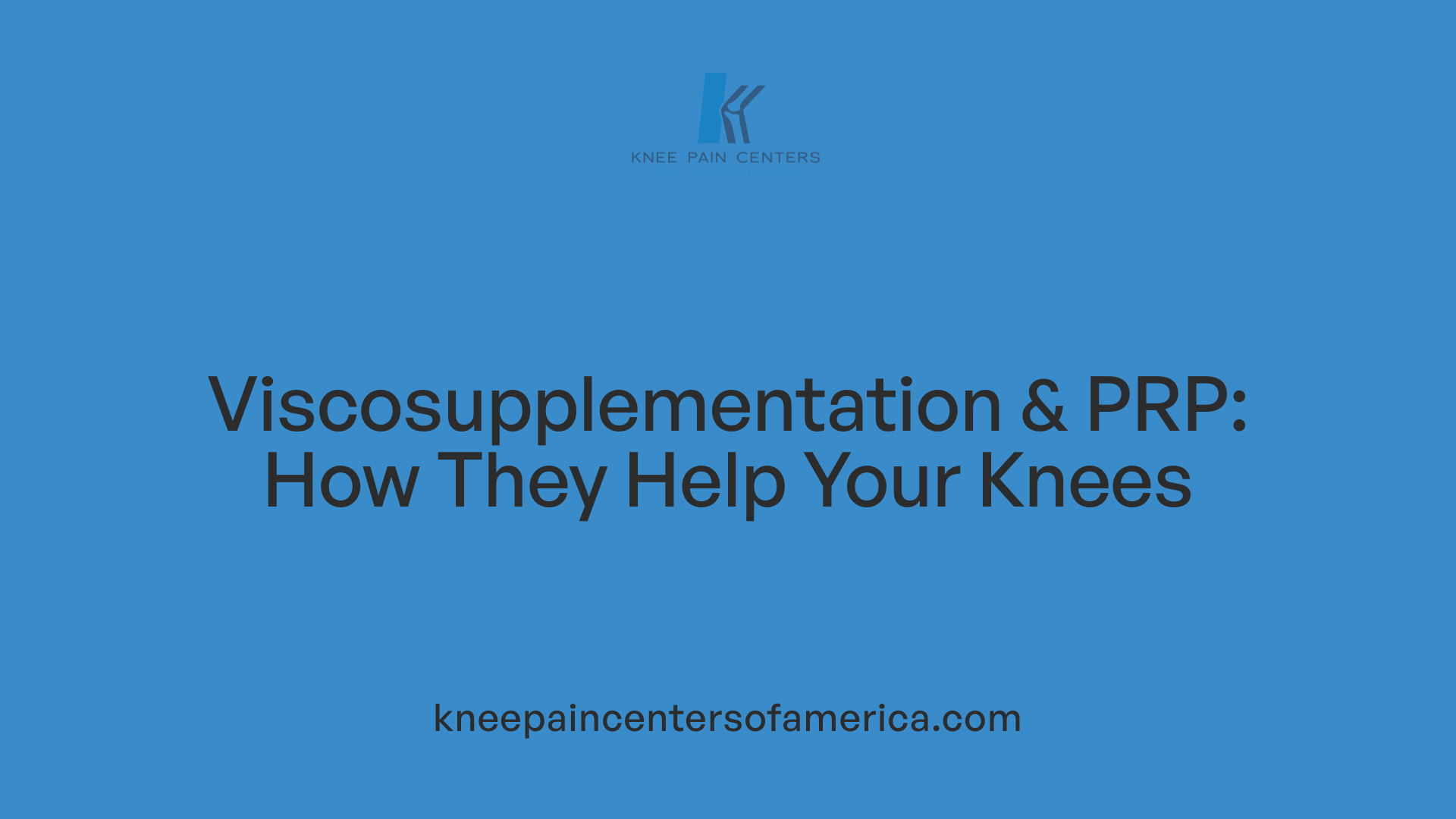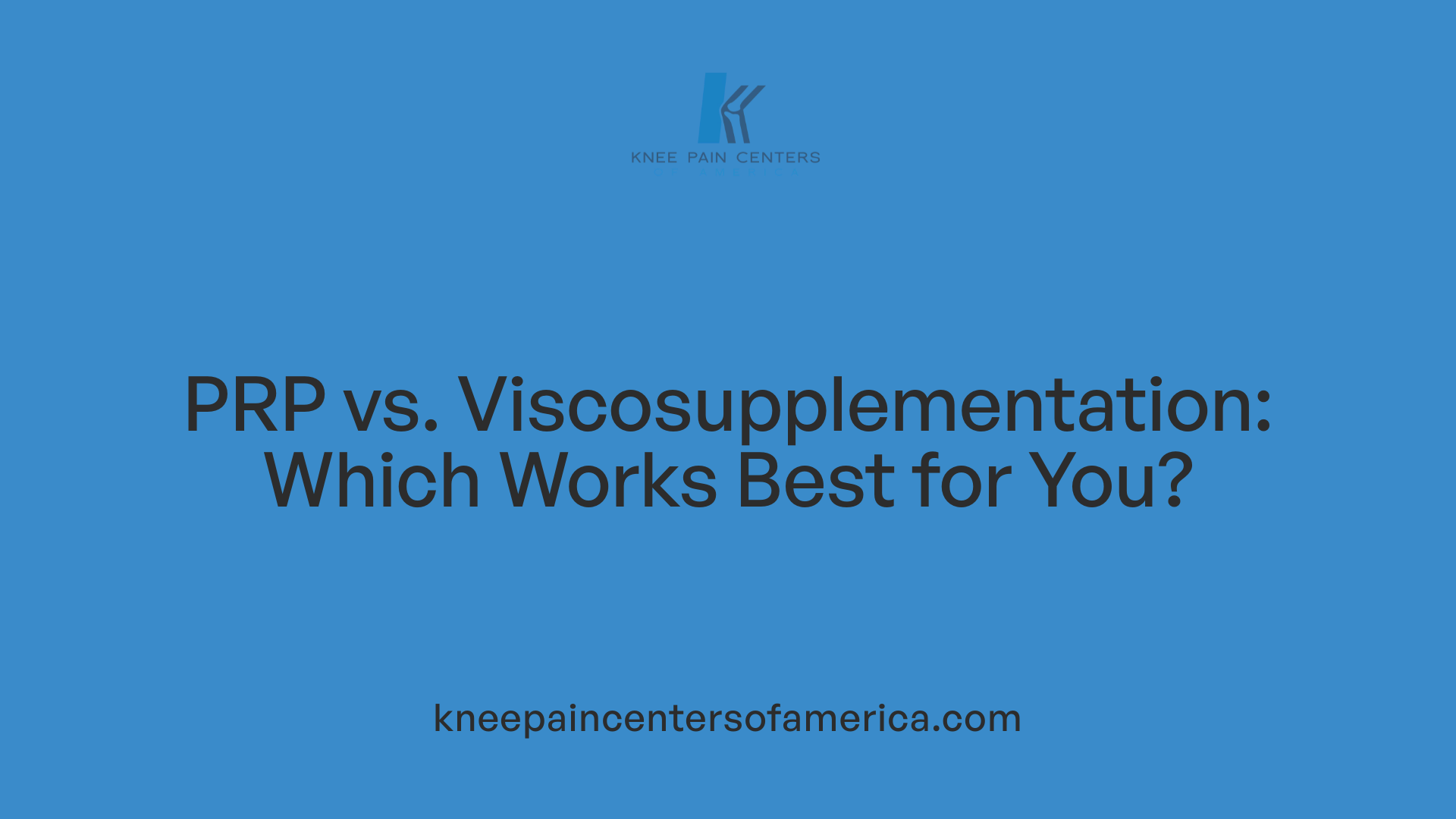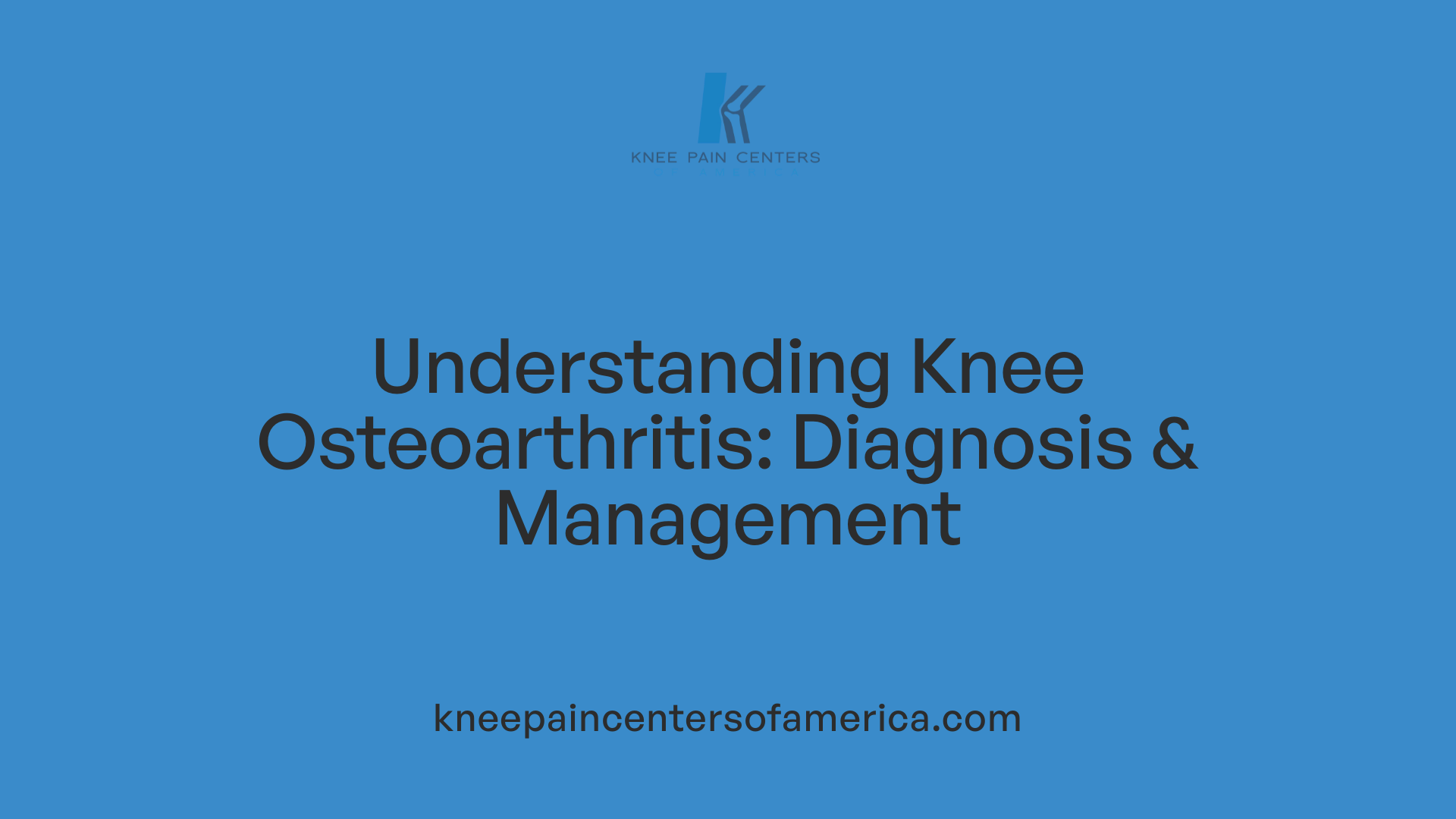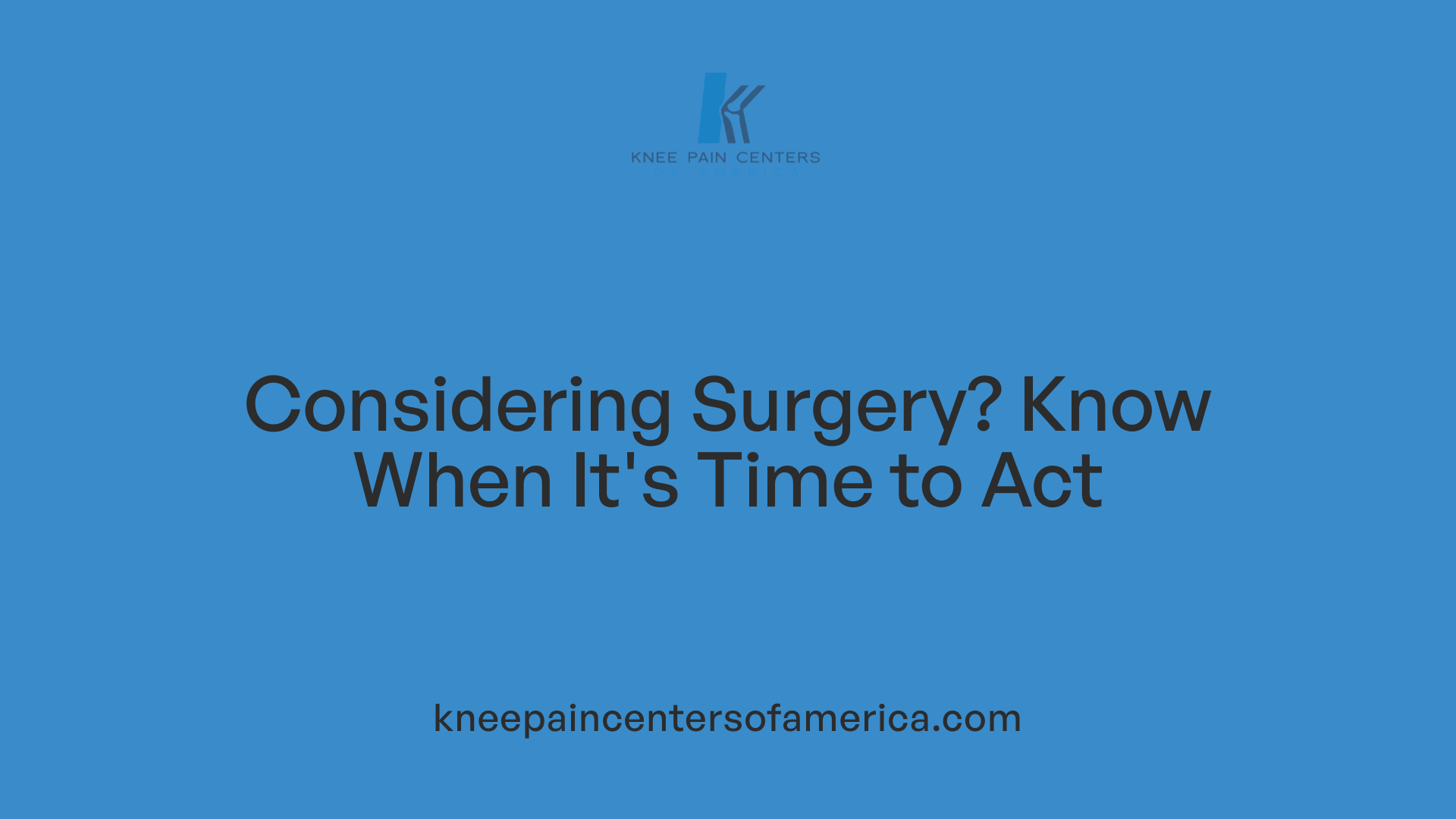Understanding Knee Pain Treatments: Viscosupplementation vs. PRP Therapy
Knee osteoarthritis and chronic joint pain have become widespread issues affecting mobility and quality of life. Among various treatment options, viscosupplementation and platelet-rich plasma (PRP) therapy have gained attention for their unique approaches to managing symptoms and potentially improving joint function. This article explores the key differences, mechanisms, and effectiveness of these two injection therapies, offering a clearer understanding to help patients and clinicians make informed decisions.
Knee Osteoarthritis Treatment Facts
- Viscosupplementation involves injecting hyaluronic acid to restore joint lubrication and improve movement.
- PRP therapy uses concentrated platelets and growth factors from the patient's own blood to promote tissue repair and reduce inflammation.
- Viscosupplementation primarily targets joint lubrication and cushioning, while PRP promotes regeneration and healing of tissues.
- Both treatments are administered via intra-articular injections with low risk of adverse effects, often guided by imaging.
- PRP typically provides longer-lasting pain relief (6-12 months) compared to viscosupplementation's 4-6 months.
- Clinical studies show PRP has superior long-term outcomes over hyaluronic acid for osteoarthritis management.
- PRP is more suitable for younger patients and those with early-stage osteoarthritis, aiming for tissue regeneration.
- Viscosupplementation is preferred for moderate osteoarthritis, especially in older patients seeking symptom relief.
- Both therapies serve as non-surgical options and can delay the need for joint replacement surgery.
- Treatment choice depends on individual factors like age, severity, cartilage condition, and patient preferences.
1. How Viscosupplementation and PRP Therapy Work to Alleviate Knee Osteoarthritis Symptoms

What is the basic mechanism of viscosupplementation?
Viscosupplementation is a treatment that involves injecting hyaluronic acid (HA) — a gel-like, naturally occurring substance — directly into the knee joint. In osteoarthritis, the cartilage breaks down, leading to reduced natural HA, which normally lubricates and cushions the joint. By supplementing this lost hyaluronic acid, viscosupplementation helps restore joint lubrication, improve cushioning, and make movement smoother and less painful.
This therapy is especially effective in patients with mild to moderate osteoarthritis who still have some cartilage left. The treatment typically takes place in a doctor's office, involves minimal discomfort often managed with local anesthesia, and the effects generally emerge within 4 to 6 weeks lasting for up to 6 months. Repeat injections can be given if necessary. Common side effects include temporary soreness or swelling at the injection site. Rarely, patients may experience pseudoseptic reactions or allergic responses, though these are unusual.
How does PRP therapy work?
Platelet-rich plasma (PRP) therapy is a regenerative treatment derived from the patient's own blood. The blood is processed to concentrate platelets and growth factors, such as platelet-derived growth factors and bioactive proteins. These components stimulate tissue repair, reduce inflammation, promote proliferation, and encourage angiogenesis (the formation of new blood vessels).
PRP injections target various soft tissues — including tendons, ligaments, and cartilage — regardless of their natural blood supply. This makes PRP versatile for treating not only cartilage degeneration but also related joint soft tissue damage. PRP is injected into the joint under image guidance to ensure accuracy, usually over a series of 3 injections.
Being an autologous treatment, PRP carries minimal risk of allergic reactions. Side effects are usually limited to temporary soreness, swelling, or stiffness at the injection site. PRP is a low-invasive, one-step procedure with minimal adverse reactions, making it an appealing option for many patients.
What are the differences in target tissues and biological effects?
| Treatment |
Target Tissues |
Primary Biological Effects |
| Viscosupplementation (HA) |
Cartilage and joint fluid |
Restores lubrication and joint cushioning, improves viscoelasticity, reduces mechanical friction |
| PRP Therapy |
Cartilage, tendons, ligaments |
Delivers growth factors to promote tissue regeneration, reduce inflammation, and stimulate healing |
Viscosupplementation mainly supplements the mechanical environment by restoring hyaluronic acid within the joint fluid. PRP, by contrast, provides biological stimulation to repair and regenerate damaged tissues, potentially addressing the underlying mechanisms of degeneration.
How are the procedures applied, and how safe are they?
Both therapies are delivered via intra-articular injections, meaning they are administered directly into the knee joint. Typically, image guidance like ultrasound or fluoroscopy is used to ensure precise injection placement.
Viscosupplementation: Usually involves one or multiple injections depending on the product and regimen. It is a quick, office-based treatment. Side effects are rare but can include mild joint swelling and injection site pain.
PRP Therapy: Involves drawing the patient’s blood, processing it to concentrate platelets, and injecting it into the joint. Multiple injections (often three) spaced over weeks may be used. Side effects are minimal due to the autologous nature of the therapy, mainly transient local discomfort.
Both treatments have low risks and are typically attempted after conventional therapies like physical therapy and medications have failed and before considering surgery. Allergic reactions are rare to non-existent with PRP and uncommon with hyaluronic acid injections. These injections do not rule out potential future knee replacement and can serve as a bridge to maintain function and reduce pain.
What are the most effective medical treatments available for knee pain?
Viscosupplementation and PRP therapy are notable injection treatments for knee pain, particularly in osteoarthritis cases. Viscosupplementation improves joint lubrication and cushioning, targeting mechanical symptoms caused by cartilage breakdown. PRP therapy promotes biological healing and tissue regeneration, reducing inflammation and supporting joint structures including cartilage, tendons, and ligaments.
Together, both treatments represent minimally invasive options with low adverse effects, often used when conservative treatments like medications and physical therapy do not provide adequate relief. They are typically administered by orthopedic surgeons or sports medicine specialists and may be combined as part of a comprehensive approach. PRP tends to offer longer-lasting pain relief and functional improvement especially in younger patients or those with early-stage knee osteoarthritis; viscosupplementation is more effective at improving mechanical joint function in moderate osteoarthritis.
The choice between these depends on individual factors such as age, severity of osteoarthritis, presence of other joint tissue damage, and patient preferences. Overall, these treatments help reduce pain, improve joint function, and allow patients to remain active, bridging the gap before considering surgical interventions.
2. Efficacy Comparison: Clinical Outcomes and Patient Suitability of Viscosupplementation Versus PRP Therapy

Effectiveness of viscosupplementation vs. PRP in pain relief and function
When managing knee osteoarthritis (KOA), both viscosupplementation and platelet-rich plasma (PRP) therapy offer symptomatic relief, but their efficacy profiles differ.
Viscosupplementation involves injecting hyaluronic acid (HA), a natural lubricant of the joint, to improve viscoelasticity and cushion the joint. This approach typically provides moderate pain relief and functional improvement lasting about 4 to 6 months. Patients with mild to moderate osteoarthritis often benefit most from this treatment, especially when some cartilage remains.
In contrast, PRP therapy uses the patient’s own blood, concentrating platelets and growth factors that promote tissue repair and reduce inflammation. PRP injections offer longer-lasting symptom relief, commonly between 6 and 12 months, with some studies documenting benefits extending beyond one year. This extended efficacy helps reduce pain, improve function, and enhance quality of life for KOA patients.
Clinical study results comparing PRP and hyaluronic acid
A pivotal clinical study involving 150 patients with cartilage degeneration and osteoarthritis examined PRP against different formulations of HA, including high-molecular weight and low-molecular weight variants.
- At 2 months post-treatment, PRP and low-molecular weight HA showed similar improvements in pain and function, both outperforming high-molecular weight HA.
- At 6 months, PRP demonstrated superior outcomes compared to all HA types, with significantly better reductions in pain and enhancements in joint function.
- Clinical evaluations using International Knee Documentation Committee (IKDC) and EQ VAS scores highlighted PRP’s superior impact over time.
Randomized clinical trials and meta-analyses further confirm these findings, showing PRP to consistently outperform HA and corticosteroids in mid- to long-term symptom management.
Patient factors influencing treatment choice
Treatment suitability depends on multiple patient-specific factors:
| Factor |
PRP Suitability |
Viscosupplementation Suitability |
| Age |
More effective in younger patients |
Often preferred for moderate OA, older patients |
| Disease Stage |
Best for early-stage OA or cartilage lesions |
Suitable for mild to moderate OA |
| Inflammation Level |
Reduces cytokine activity, anti-inflammatory |
Primarily lubricates joint, less anti-inflammatory |
| Cartilage Condition |
Potential to aid tissue regeneration |
Relies on existing cartilage for cushioning |
Younger patients and those with less cartilage degeneration often experience better and longer-lasting benefits from PRP injections. Conversely, viscosupplementation remains a viable option for patients with moderate osteoarthritis or those seeking symptom relief without regenerative therapies.
Longevity of symptom relief and side effects
Symptom relief from PRP lasts significantly longer than that from viscosupplementation and corticosteroids:
- PRP: Pain reduction of about 52% at one year, functional improvements sustained at least 6 months and often over a year.
- Hyaluronic Acid (Viscosupplementation): Benefits typically last 4 to 6 months, with relief diminishing after that.
- Corticosteroids: Provide rapid relief lasting 2 to 3 months, but effects fade and may worsen symptoms beyond 6 months.
Both PRP and HA injections carry low risks of adverse reactions. Common side effects include temporary soreness, swelling, or stiffness at the injection site. Allergic reactions are rare with HA and very unlikely with PRP since it uses autologous blood. PRP’s regenerative and anti-inflammatory properties may contribute to decreased inflammation markers, such as IL-1β and TNF-α, helping reduce joint pain and swelling.
Recent advancements and decision-making considerations
Recent randomized controlled trials underline PRP as a promising advancement for KOA treatment, outperforming viscosupplementation and corticosteroids in sustained pain relief and functional gains. PRP’s mechanism involving growth factors and cytokine modulation may also slow tissue degradation, though long-term disease-modifying effects remain under investigation.
Given both treatments are minimally invasive, physicians consider factors like patient age, arthritis severity, cartilage health, and desired outcomes when recommending therapy. PRP tends to suit younger patients with early arthritis stages, while viscosupplementation is beneficial for those with moderate osteoarthritis seeking improved joint lubrication.
Importantly, these therapies serve as bridges to maintain activity and delay surgery rather than cures. Use of imaging guidance during injection enhances precision and efficacy, and combining PRP with HA remains an area requiring further study.
| Aspect |
PRP Therapy |
Viscosupplementation (HA) |
Corticosteroids |
| Source |
Autologous blood platelets |
Hyaluronic acid gel |
Synthetic corticosteroid drugs |
| Pain Relief Duration |
6–12+ months |
~4–6 months |
2–3 months |
| Functional Improvement |
Superior, sustained over many months |
Moderate, diminishes after ~6 months |
Short-term, declines over time |
| Mechanism |
Tissue repair, growth factors, anti-inflammatory |
Joint lubrication, cushioning |
Anti-inflammatory, but may accelerate cartilage degradation |
| Side Effects |
Mild injection site soreness/swelling |
Mild injection site reactions, rare allergies |
Possible cartilage damage, short-term relief |
| Suitability |
Younger, early-stage OA, cartilage lesions |
Mild to moderate OA with some cartilage |
Often for flare-ups, short-term management |
In summary, PRP therapy has emerged as a more effective long-term option for suitable KOA patients, offering enhanced pain relief, functional gains, and potential regenerative benefits compared to viscous hyaluronic acid injections. Treatment decisions remain individualized, balancing efficacy, patient characteristics, and clinical goals.
Comprehensive Overview of Knee Osteoarthritis Diagnosis and Management

How is osteoarthritis of the knee diagnosed and managed?
Osteoarthritis of the knee (KOA) is diagnosed by assessing symptoms such as joint pain, stiffness, and reduced mobility, complemented by imaging techniques like X-rays and MRI. These images reveal cartilage breakdown, joint space narrowing, and other structural changes key to confirming KOA.
Management typically starts with conservative, non-surgical strategies. These include physical therapy to strengthen muscles around the joint, weight management, and medications aimed at reducing pain and improving joint function. When these approaches provide insufficient relief, physicians may introduce intra-articular injections such as corticosteroids for short-term pain relief or viscosupplementation and platelet-rich plasma (PRP) injections that offer longer symptom control.
PRP injections have gained prominence due to their regenerative potential; they deliver concentrated growth factors from the patient’s own blood to reduce inflammation and promote tissue healing in the knee. Viscosupplementation supplements joint lubrication by injecting hyaluronic acid to reduce friction and improve movement, particularly effective in mild to moderate osteoarthritis.
Surgical options, like osteotomy or total knee replacement, are reserved for advanced KOA cases unresponsive to conservative care. Treatment decisions are made by orthopedic surgeons and rehabilitation specialists who consider patient age, OA severity, and overall health, ensuring a comprehensive, individualized management plan that optimizes joint function and quality of life.
Non-Surgical Treatment Options for Knee Osteoarthritis Symptoms

What non-surgical therapies are available to relieve knee osteoarthritis symptoms?
Managing knee osteoarthritis (KOA) without surgery involves a range of strategies focused on symptom relief and functional improvement. These include physical therapies, medications, and joint injections.
Physical therapies and activity modification
Physical therapy plays a critical role, emphasizing muscle strengthening, flexibility exercises, and low-impact activities like swimming or cycling. Weight management and orthotic supports also help reduce joint stress, improving stability and decreasing pain.
Medications and joint injection therapies
Pharmacologic treatments commonly involve nonsteroidal anti-inflammatory drugs (NSAIDs) to control pain and inflammation. For more targeted relief, intra-articular injections provide additional benefits:
- Corticosteroid injections offer rapid but short-term pain relief lasting a few weeks to months, often used for flare-ups.
- Hyaluronic acid (HA) injections—a process known as viscosupplementation—inject a gel-like substance to restore lubrication and cushioning in the joint, improving movement and reducing pain for approximately 4 to 6 months.
- Platelet-rich plasma (PRP) injections use the patient’s own concentrated platelets containing growth factors that reduce inflammation and promote tissue repair. PRP has demonstrated longer-lasting pain relief and functional improvement, often outperforming HA and steroids, especially in younger patients with early-stage arthritis. PRP’s effects can persist for 6 to 12 months or more.
Emerging regenerative treatments
Beyond these established methods, regenerative treatments like stem cell therapies and genicular artery embolization are under exploration, showing promise but still requiring more research to confirm efficacy.
These non-surgical options provide a valuable “bridge” to delay or avoid surgery by reducing pain and improving joint function. Treatment choice is personalized based on factors such as age, arthritis severity, and patient preferences, typically guided by orthopedic specialists who can tailor approaches for the best outcomes.
When to Consider Surgical Intervention for Knee Osteoarthritis

Indications for Surgery
Surgery is typically considered for knee osteoarthritis when conservative treatments such as physical therapy, medications, and intra-articular injections (like PRP or hyaluronic acid) fail to adequately relieve symptoms or maintain joint function. Persistent pain that significantly limits daily activities, along with weakness and reduced mobility, are strong clinical indicators for surgical evaluation. Imaging studies often reveal advanced joint degeneration, cartilage loss, or bone-on-bone contact, confirming the need for surgical intervention.
Types of Surgical Options
Several surgical options are available depending on the severity of osteoarthritis and patient-specific factors:
Total Knee Replacement (TKR): The most common surgery for severe OA, replacing damaged joint surfaces with prosthetic components to restore function and relieve pain.
Joint-Preserving Procedures: For patients with milder or localized disease, procedures like osteotomy (realigning bone) or arthroscopic surgeries can help delay joint replacement by reducing stress on affected areas.
Partial Knee Replacement: Targeted for one compartment of the knee in cases where the disease is limited, preserving healthy cartilage elsewhere.
Decision-Making Process
Choosing surgery involves a collaborative process between the patient and an orthopedic surgeon. Factors considered include:
Symptom Severity: Degree of pain and functional impairment.
Overall Health: Presence of comorbidities that might affect surgical risk.
Age and Activity Level: Younger or more active patients might benefit from joint-preserving options or delay TKR.
Goals and Expectations: Understanding the risks, benefits, and recovery involved in surgery.
Through shared decision-making, the surgeon helps interpret clinical findings and imaging results to tailor the surgical plan to the individual's needs and preferences, optimizing outcomes.
Choosing Between Viscosupplementation and PRP: Making an Informed Decision
Viscosupplementation and PRP therapy represent two important injection-based options to manage knee osteoarthritis and chronic joint pain. Each has distinctive mechanisms and clinical strengths: viscosupplementation primarily restores joint lubrication to ease movement, while PRP leverages the body's healing power to reduce inflammation and promote tissue repair. Clinical evidence increasingly favors PRP for longer-term pain relief and functional improvement, particularly in younger or less advanced cases, but viscosupplementation remains a useful option for moderate osteoarthritis. Ultimately, treatment selection should be personalized, guided by patient-specific factors and consultation with healthcare professionals to optimize outcomes and quality of life.
References